Mary Anne Yarde's Blog: The Coffee Pot Book Club , page 120
October 4, 2019
Sarah Dahl's fabulous book,Tales of Freya, is now available on #NetGalley #Viking sensual #romance @YourNewBooks @sarahdahl13
Have you heard…?
Sarah Dahl's fabulous book, T ales of Freya , is available on NetGalley for your reading pleasure. If you love great historical erotica then this is the book for you.

Tales of Freya
Sensual Short Stories
By Sarah Dahl

In this collection of adult bedtime stories, Sarah Dahl pulls back the curtain of history to depict the erotic lives of Viking men and women. Amid the stark landscapes of fjords, forests and snowcapped mountain peaks, her characters search for love and passion. Dahl authentically illuminates the sensual side of a world of battle and plunder in an alluring collection perfect for every lover of gritty Viking romance.
A warrior recovering by a river is drawn into an unforeseen skirmish with a beautiful shield maiden. An enslaved Christian monk is entranced by his captors' pagan allure. A dissatisfied housewife finds that her home holds an unexpected and liberating secret. An injured farmer is captivated by the magic of his irresistible healer ...
In a world of crackling fires and rough landscapes, long winters and bloody raids, the immediacy of life and death ignites undeniable passions. Warriors and monks, healers and housewives - all follow the call of their hearts and bodies to indulge in pleasures that may forever change their lives.
To grab your copy of
Tales of Freya
Click
HERE!

What is NetGalley?
How It Works (in their own words…)NetGalley connects publishers and authors to an enthusiastic community of early influencers who will help their book succeed: librarians and booksellers who order and recommend books to their patrons, media professionals who interview authors, reviewers and bloggers who write about books online and leave reviews on retail sites, and more. Publishers and authors list their titles on NetGalley for members to request, read, and review, and members gain free access to a vast catalog of digital review copies.
NETGALLEY FOR MEMBERS
NetGalley is a service to help readers of influence discover and recommend new books to their audiences. If you are a reviewer, blogger, librarian, bookseller, educator, journalist or other member of the media, you can use NetGalley for free to request, read, and recommend books before they are published.Your reviews and feedback are essential to publishers and other readers!
Become a NetGalley member today! NetGalley
NetGalley for Authors
Are you an author? Would you like to see your book on NetGalley. The Coffee Pot Book Club offers affordable NetGalley promotion. Click HERE to find out more.
Published on October 04, 2019 09:33
October 3, 2019
Join #HistoricalFiction author, Derek Birks, as he explores the Dark Ages. There is also the chance to check out Derek’s fabulous new book — The Last of the Romans. #History #DarkAges @Feud_writer
The Fifth Century: A Car Crash of History and LegendBy Derek BirksRecently I wrote a new book: The Last of the Romans . For me, it was a major change of focus after seven novels set in the late medieval period, because this one is set in the fifth century.

As long as I can remember, I’ve been captivated by the period of history just after the end of Roman imperial government in Britain. But, hand in hand with that fascination, goes more than a little trepidation. Why? Because fifth century Britain is a subject about which a great deal has been said and written, but very little is actually known.For starters, it is relentlessly repeated that the Romans ‘left’ Britain in 410 AD. Some writers have even said ‘the last Roman soldier’ left Britain in 410 AD. I mean, really - the very last one? Surely we don’t know that. Well, no we certainly don’t! But then we don’t know anything much about the end of Roman Britain. Traditional textbooks emphasised that the Romans left Britain – they abandoned those poor, defenceless Britons to fend for themselves… But did Rome abandon Britain, or did Britain abandon Rome? If the latter was the case, then surely the narrative would have been rather different? The few known events can be interpreted in both ways.So, why then, is this idea of the Romans abandoning Britain so widely accepted and believed? The answer is very simple: for centuries, those interested in studying what happened in the fifth century, could rely only on a handful of texts by early scholars – none of whom intended to write what we would recognise as history. Nevertheless, whatever these authors said had to be respected because there was no other source of information about the period. The ubiquitous date of 410 AD, for example, is supplied by only one source, but in a landscape of hardly any sources, one is quite a lot!Over the past fifty or so years, all that has changed because we now have a wealth of information from archaeology and scientific analysis which has provided a much needed perspective. With decades of this data analysis under our belts, we can begin to form a few different impressions about how people in the fifth – and the adjacent centuries – lived. One thing is clear from the archaeological record: the changes that occurred in Britain – and for that matter most of the Roman Empire in the west – happened not in a few short years but over centuries. There was not a sudden or rapid collapse of Roman authority but a gradual, evolutionary series of changes in the nature of the ageing empire.Well, all this new information sounds promising, doesn’t it? And, in many ways, it is; but there is one area of the development of Britain after Rome where this new evidence sheds very little light: political life. There we are forced to fall back upon the old texts once again and though they give us plenty of names of prominent men – largely men, no surprise there – there is no political context for them. Often, these references are as misleading as they are helpful. What lands did these individuals rule? Were they kings, war leaders or simply prominent citizens? Was there a ruling class? If so, did it derive its power from wealth, military prowess or was it simply dynastic? None of this is known.
 Vortigern.Alas, the procession of names tells us very little, so when it comes to trying to work out who ruled over whom, for how long and why, we are not much further ahead than the Victorians were. Without laboriously going through very many of them, here are two obvious examples. I have read accounts both in fiction and non-fiction about a figure called Vortigern – usually described by modern authors as a fifth century British king. But was he? We don’t even know for certain whether Vortigern was a man’s name or just his title. Are the references to Vortigern rooted in fact, or are they legend?Two other names associated with Vortigern in the middle of the fifth century are Hengist and Horsa. These, we are told, were two brothers who were leaders of an early Saxon invasion of Britain. But surely these are just names discovered by early Saxon chroniclers who themselves were writing long, long after the events. Was the story of the brothers part of an oral history, passed down over many generations? If so then it would surely have been altered during that time. Perhaps they did exist but is it a coincidence that many different cultures share a tradition of stories in which a nation is founded by two brothers? We cannot be sure there was ever really a Hengist, or a Horsa, yet they are frequently referred to as if they are actual historical figures.Then, into this chaos of random names we toss an incendiary grenade called King Arthur.
Vortigern.Alas, the procession of names tells us very little, so when it comes to trying to work out who ruled over whom, for how long and why, we are not much further ahead than the Victorians were. Without laboriously going through very many of them, here are two obvious examples. I have read accounts both in fiction and non-fiction about a figure called Vortigern – usually described by modern authors as a fifth century British king. But was he? We don’t even know for certain whether Vortigern was a man’s name or just his title. Are the references to Vortigern rooted in fact, or are they legend?Two other names associated with Vortigern in the middle of the fifth century are Hengist and Horsa. These, we are told, were two brothers who were leaders of an early Saxon invasion of Britain. But surely these are just names discovered by early Saxon chroniclers who themselves were writing long, long after the events. Was the story of the brothers part of an oral history, passed down over many generations? If so then it would surely have been altered during that time. Perhaps they did exist but is it a coincidence that many different cultures share a tradition of stories in which a nation is founded by two brothers? We cannot be sure there was ever really a Hengist, or a Horsa, yet they are frequently referred to as if they are actual historical figures.Then, into this chaos of random names we toss an incendiary grenade called King Arthur.  Arthur.
Arthur.With him, Arthur brings more baggage than your average Roman Emperor: a few dubious relatives, a shed load of knights – obviously - a dodgy queen and, of course, a sorcerer with a magic sword – and let’s not forget about the sodding round table! Magic, knights, battles, ladies – what’s not to like? True enough, but is it history? No, it’s not.The result of all this uncertainty is that the life’s work of a legion of historians, authors, archaeologists and antiquarians – not to mention a billion interested bystanders – is to attempt to make some sense out of this car crash of legend and history. Was there a real Arthur, or was he just the hero everyone wanted to believe in? The enduring enthusiasm for this period is explained not so much by a desire to find out what happened, but to explore – indeed, wallow in - the possibilities of what might have happened.So, what are we to do? We are hooked on it – and thus we embark upon a jigsaw puzzle that not only has 95% of its pieces missing, but also includes dozens of pieces from several entirely different puzzles! It’s a hopeless task, but we just can’t leave it alone. Yet, for the writer of historical fiction, this insoluble puzzle with so many blank spaces is nothing short of gold dust! We have such a free hand we might almost be writing fantasy! Which brings me to my new hero, Ambrosius Aurelianus, who is mentioned by name in the writings of the sixth century monk, Gildas - and indeed given a certain amount of actual context. But still, we know almost nothing about him: his origins, childhood and young adult life are all extremely hazy. But the novelist cannot be so vague; my Ambrosius needed a backstory, a life before he became noteworthy in fifth century Britain. The Last of the Romans is an attempt to give a plausible – if not actual - life to a young 25 year old Ambrosius. From the wealth of new information I referred to above, I have been able to attempt to recreate the world in which young Ambrosius might have lived. Ambrosius, the man, is lost to us, but I can offer a ‘virtual’ Ambrosius set in the turbulent world of the mid-fifth century.
The Last of the RomansBy Derek Birks

'The Story of Dux and his men pulled me in at once.' Peter Tonkin, author of The Ides454 AD. Northern Italy.Dux Ambrosius Aurelianus has served the Roman Empire with distinction.His bucellarii, a small band of irregular soldiers, have helped to bring a fragile peace to the beleaguered empire in the west. But, with the empire now at peace, his master, Flavius Aetius, decides to chain up his dogs of war. Ambrosius and his men are left to idle away their days in a rural backwater, but Ambrosius’ boredom is brutally swept aside when old rivals seize the opportunity to destroy him.Pursued as a traitor by the imperial guard, Ambrosius takes his loyal band, along with other dissident soldiers and a Saxon girl, Inga, into the mountains. Since nowhere is safe, Ambrosius travels north, across the crumbling ruins of the empire, to his estranged family in Gaul. But there too, he finds nothing but conflict, for his home town is now besieged by a small army of rebellious Franks.Freedom and peace seem a world away. Whatever course the soldier takes, Ambrosius and his bucellarii will need to muster all their strength and skill to survive.At the twilight of the empire, they may be the Last of the Romans…'Fast-paced and action-packed.' Richard Foreman, author of Spies of Rome
The Last of the Romans , published in paperback on October 1st, is also available as an e-book, published by Sharpe Books:Amazon UK • Amazon US
Derek Birks
 Derek was born in Hampshire in England but spent his teenage years in Auckland, New Zealand, where he still has strong family ties.
Derek was born in Hampshire in England but spent his teenage years in Auckland, New Zealand, where he still has strong family ties. For many years he taught history in a secondary school but took early retirement to concentrate on writing. Apart from his writing, he spends his time gardening, travelling, walking and taking part in archaeological digs.
Derek is interested in a wide range of historical themes, but at the start of his writing career he focused on the late medieval period. He writes action-packed fiction which is rooted in accurate history.
His debut historical novel, Feud,is set in the period of the Wars of the Roses and is the first of a series entitled Rebels & Brothers which follows the fortunes of the fictional Elder family. The fourth and final book of the series, The Last Shroud , was published in the summer of 2015 and Derek then embarked on a new Wars of the Roses series, entitled The Craft of Kings , and comprising so far: Scars from the Past, The Blood of Princes and Echoes of Treason. The Elders will return in the fourth and final book of the series, Crown of Fear in 2020.Derek’s most recent work, The Last of the Romans , is set in the turbulent fifth century and centres upon the shadowy historical figure of Ambrosius Aurelianus.
Connect with David: Website • Blog • Twitter • Facebook.
Published on October 03, 2019 23:20
An Author’s Inspiration: The Basques and the Sea by Amy Maroney #amwriting #HistoricalFiction @wilaroney
An Author’s Inspiration: The Basques and the SeaBy Amy Maroney
Not too long ago, I was lucky enough to spend most of a year traveling through Europe with my family. I had brought with me the beginnings of a novel which I affectionately titled The Sunscreen Caper, a pharmaceutical thriller about the evils lurking in the shadowy world of sunscreen manufacturers.
As I was besotted with Swedish crime writer Henning Mankell at the time, the first few chapters were littered with characters shivering in the snow and downing cups of bitter black coffee whilst eating open-faced sandwiches. The only real differences between my story and Henning Mankell’s novels were a) it took place in Boston rather than in some remote Swedish town; and b) it was a lot worse than anything Mankell had ever published.
But I digress. About halfway through that travel adventure I was struck with a bolt of creative lightning that I never saw coming. My experiences in Europe forced me to abandon ship and turn in a completely different direction. (For a full explanation of what happened, read my previous post on this blog.) Now I was obsessed with one thing and one thing only: writing the Miramonde Series, a trio of historical mysteries about a Renaissance-era woman artist and the modern-day scholar on her trail.

As I dove into research, I discovered elements of history that created rich subplots for the trilogy, gave depth to my characters, and helped drive the plot forward. In Book 1, The Girl from Oto, the lucrative trade in Spanish merino wool and the pilgrim’s route of Camino de Santiago created a foundation for the world my characters inhabited—and motivated many of their actions and desires. In Book 2, Mira’s Way, I plumbed more veins of history: first, I layered in a subplot about a mysterious and persecuted people, the Cagots; then, I added twists involving the Toulouse merchants made rich by blue dye extracted from the woad plant. Finally, with Book 3, A Place in the World, I mined the recesses of Basque history and came up with a dizzying array of materials about whaling, the cod fishery, and Basque cultural traditions.
 Photograph by Alexander Andrews.
Photograph by Alexander Andrews.I learned that the Basques have a long history of maritime expertise and exploration. In fact, when other Europeans “discovered” the codfishing grounds off Newfoundland in North America in the early 16thcentury, the Basques had already been quietly fishing there for a long time. I was thrilled to read about Canadian researcher Selma Huxley Barkham, who discovered a trove of records in Spain documenting the lucrative 16thcentury Basque whaling industry and then went home to Canada and found the remains of the Basque whaling stations along the Newfoundland coast. Here’s a great interactive graphic by the National Geographic Society that illustrates the Basque whaling industry in the mid-1500s.
 Photograph by Tom Sekula.
Photograph by Tom Sekula.Along with other sources, such as Mark Kurlansky’s excellent books Codand A Basque History of the World, I found an excellent history written by French scholars about the city of Bayonne (which features large in A Place in the World). I learned that whalers were required to tithe upon return from the sea by donating the best part of the whale—the tongue—to the Catholic church in Bayonne. And I learned that the Basques were expert whale hunters, with their harpooners launching weapons from sleek chalupas—small oak vessels that were dispatched from the larger whaling ships.
I also discovered fascinating lore about Basques and Basque homes in my research. For example, in Basque tradition, the eldest child inherits the homestead, whether female or male. All the other children must make their own way in the world, like my character Xabi, who becomes a nomadic shepherd. In the book Basque People by Dorothy Canfield Fisher (very hard to find, but a friend loaned me her first edition copy of it), I saw images of Basque family marks or designs that gave me the idea to have my modern-day heroine tracking down such a design during her travels around northwestern Spain.
All of these nuggets of history make their way into the story, with surprising results.
 Photograph by Jon Tyson.
Photograph by Jon Tyson.When I first started writing the Miramonde Series, I was obsessed with the desire to shine a light on women artists whose stories had never been told. I never dreamed that wool, pilgrim routes, the humble woad plant, the mysterious Cagots, the whaling and codfishing industries, and Basque culture would be the source of so much inspiration, too.
While it’s a shame to let a book titled The Sunscreen Caper go to waste, I can’t say I’m sad that our year of travels derailed my dream of writing a pharmaceutical thriller. In fact, I look forward eagerly to the next bolt of lightning—I’ll be starting research on a new book series soon, so energy is already brewing in the sky, getting ready to zap me with new inspiration.
A Place in the World(The Miramonde Series, Book 3) By Amy Maroney

The secrets of the past are treacherous…and irresistible.
A Renaissance-era female artist and an American scholar. Linked by a centuries-old mystery…
1505: Pregnant and reunited with the love of her life, artist Mira survives a harrowing journey to the city of her dreams. But Bayonne is nothing like she imagined. Navigating a dangerous world ruled by merchants and bishops, she struggles to reignite her painting career. When an old enemy rises from the shadows, Mira’s life is thrown into chaos all over again—and she is faced with a shattering decision.
2016: Scholar Zari seizes the chance to return to Europe as a consultant for an art dealer. Overwhelmed by her job, she has little time to hunt for clues about Mira. But when art experts embrace a theory that Mira’s paintings are the work of a famous man, Zari must act. Racing against time, she travels to a windswept corner of Spain. What she discovers there solves the puzzle of Mira forever—and unlocks the secrets of Zari’s own past.
A thrilling tale of obsession, mystery, and intrigue, this mesmerizing saga will stay with you long after you read the last page.
Excerpt
Autumn, 1506Lourdes, Béarn
Mira stood in the center of the entry hall, her head throbbing. The clatter of crockery rang out from the kitchens, but the innkeeper was nowhere in sight. Nor were any servants. In fact, the only sign of life was a tawny cat curled on its haunches by the doorway.
She and the cat stared at each other. Its eyes looked remarkably like her own. Gray-green, wide, slanted up at the corners. She took a deep breath, then regretted it. The stale air smelled of tallow and boiled cabbage.
Outside, a rooster crowed.
Mira went to the door and nudged it open, desperate for a distraction from the sour taste in her mouth. The cat slunk past her skirts and padded into the bright morning sunlight. It stopped for a moment, taking the measure of the courtyard, then sauntered toward three chickens pecking at grain near the stables. At its approach, they sidled nervously away.
Wise chickens, Mira thought. You never know what a cat will do.
Two merchants descended the stairs behind her, their boots heavy on the treads. Mira moved into the shadows as they strode through the entry hall and out the door. She had become adept at slipping through the world unnoticed since this journey began. The habit did not come naturally to her. But as a woman traveling alone, her life depended on it.
A Place in the World is available for purchase from Amazon, Kobo, iBooks, and Nook.
Amy Maroney
Published on October 03, 2019 19:30
October 2, 2019
Join Historical fiction author, Alex Marchant as she talks about what inspires her writing @AlexMarchant84
An Author’s Inspiration
By Alex Marchant
I’ve long appreciated the importance of place in my own writing – and therefore the value of location research. My first children’s novel, Time out of Time, was set in a fictionalized version of my childhood home – not that I grew up in a huge dilapidated house in the country, but that old house is set within a landscape that is an amalgam of the village on the edge of suburbia where I grew up, the local public open space (a small river valley with the remnants of a Victorian gunpowder mill strung out along it), and the rolling downland thereabouts. My great writing hero, Susan Cooper, once said that she found it easier to write about the England of her youth when she had been living in the USA for some years. Perhaps the same was true of me, looking back to my Surrey childhood once I’d lived in Yorkshire for much of my adult life.
 ‘A packhorse bridge – remnant of the nineteenth-century gunpowder mill’
‘A packhorse bridge – remnant of the nineteenth-century gunpowder mill’However, being immersed in the Yorkshire countryside proved to be invaluable at the time of writing my first historical novel, The Order of the White Boar. The book, telling the story of the real King Richard III for younger readers, is set largely in and around his primary home of Middleham Castle in Wensleydale, North Yorkshire (as well as London and the royal court at Westminster). Wandering up on the deserted moors around my home in West Yorkshire’s ‘Bronte Country’ allowed me to step back into a somewhat similar landscape to that around Middleham. I could easily imagine my characters riding, hunting, hawking, picnicking (sorry – too modern a word perhaps!) five centuries ago as I strode across the heather-, bilberry- and bracken-clad hills and witnessed at first hand the effects of the changes of the seasons. Readers seem to think it worked, with one reviewer saying, ‘From the minute I picked up this book, I was transported back to Yorkshire...riding the Middleham gallops, travelling the roads to York…’
 ‘Bronte Country’
‘Bronte Country’I was fortunate to live in the area while writing the book. Other locations, for the second book in the series, The King’s Man, which ranges further afield, had to be specially visited to gain a proper feel for them. Some had already been on my Richard III itinerary in previous years, but a revisit can always potentially pay dividends, reminding of small details or atmosphere. Other places were totally new for me. For instance, despite having plenty of ancestors who hailed from Suffolk, I’d never set foot in the county when deciding to set the climactic scenes of the book there. So a combined family history/location research holiday there was arranged.
 ‘Gipping chapel, on the estate of Sir James Tyrell – a place with a rumoured Ricardian connection – and next door to my ancestral village…’
‘Gipping chapel, on the estate of Sir James Tyrell – a place with a rumoured Ricardian connection – and next door to my ancestral village…’I’m so glad that decision was made. Standing in the scores (alleyways) of Lowestoft, I could almost see and hear the final scenes play out – even feel the sea fret closing in although it was a bright spring day. Those scenes couldn’t have been set anywhere else.
 One of the ancient ‘scores’ of Lowestoft.
One of the ancient ‘scores’ of Lowestoft.I’ve recently been undertaking location research for the third book in the series. It’s also been a great excuse to catch up with an old friend who now lives in the Lake District, not far from some of the places in the book – handy for overnight stays! With the working title ‘King in Waiting’, the book covers the couple of years immediately following the Battle of Bosworth in 1485 – a tumultuous time of unrest and outright rebellion – as the usurper Henry Tudor struggles to keep control of England in the face of continuing resistance from those loyal to the House of York – and to King Richard’s memory. It’s a time of strife often glossed over by the notion that Tudor ‘brought peace’ after the Wars of the Roses by marrying Elizabeth of York and combining the two royal houses. More propaganda, of course: there had been peace in England since the Battle of Tewkesbury in 1471 – as fifteen-year-old ‘leading man’ Matthew says in the latter part of The King’s Man, ‘What war has there been in our lifetime – until Tudor came?’ And rebellions against Tudor continued for at least fifteen years after he took the crown.
One of the most significant incidents during that time is the so-called Lambert Simnel rebellion, named after its supposed figurehead, recorded by the later official histories as being a ten-year-old imposter from Oxford. The real story is a little more complicated and ‘King in Waiting’ explores a possible scenario, drawn from the confusion of the earliest sources. These very much contradict the official story, which only coalesced over several months. But some facts we do know include the arrival of the rebel army from Dublin at a tiny place called Piel Island in Cumbria and its remarkable march across the spine of England to Masham in North Yorkshire in just five days. The rebels were on foot or on horseback, probably with waggons of arms and equipment to drag across this rugged countryside.
 The mouth of Garsdale, cutting across the spine of England.
The mouth of Garsdale, cutting across the spine of England.By the miracle of modern technology (my trusty Suzuki) I did the journey spread over three days, breaking it up into particular places I wanted to visit. The final day I spent travelling the last leg – from Kendal, via Sedbergh, through Garsdale to Wensleydale and Masham – all in one chunk, to experience what it would have been like for Matthew and his companions – and, in his case, the prospect of a return ‘home’ to Middleham on the way.
I doubt I would ever have visited Piel Island, with its somewhat neglected castle, if not for this research. It’s tucked away right at the end of a southern peninsula of Cumbria and seems to have relatively few visitors. But I’m so glad I made the trip. Seeing the place – hearing, feeling and smelling it – sparked so many ideas for the story. Also, talking to the boatman who ferried me across the deep channel to the castle, answered a nagging question I’d had that couldn’t have been resolved by simply looking at a map or photographs. Why had the rebels landed the army with all its gear on an island off the coast if they then had to transport everything across the water again…?


 ‘Piel Castle and the approach to the island across the water…’
‘Piel Castle and the approach to the island across the water…’Visiting the places where your characters once were – for me it’s a vital part of my research. Of course it’s a lot easier if you live in the place, or reasonably near, where your book is set (though I’ve also popped over to Flanders for this work-in-progress). Or, alternatively, it can offer a fantastic excuse for a good holiday. I have the germ of an idea for a novel set in the Roman or Byzantine period in southern Turkey … I wonder whether a fortnight would be long enough to visit all the locations?
 ‘I’m not entirely sure this beach was here in the third century AD…’
‘I’m not entirely sure this beach was here in the third century AD…’Alex Marchant
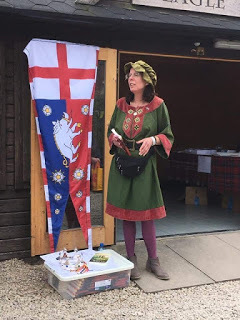 Alex Marchant was born and raised in the rolling Surrey downs, but, following stints as an archaeologist and in publishing in London and Gloucester, now lives surrounded by moors in King Richard III’s northern heartland, not far from his beloved York and Middleham.
Alex Marchant was born and raised in the rolling Surrey downs, but, following stints as an archaeologist and in publishing in London and Gloucester, now lives surrounded by moors in King Richard III’s northern heartland, not far from his beloved York and Middleham.A Ricardian and writer since a teenager, Alex’s first novel, Time out of Time, won the 2012 Chapter One Children’s Book Award, but was then put on the backburner in 2013 at the announcement of the rediscovery of King Richard’s grave in a car park in Leicester. Discovering that there were no books for children telling the story of the real Richard III, Alex was inspired to write them, and so The Order of the White Boar and its sequel, The King’s Man, were born. Together they tell King Richard’s story through the eyes of a young page who enters his service in the summer of 1482, and have been called ‘a wonderful work of historical fiction for both children and adults’ by the Bulletin of the Richard III Society.
As well as writing the third book in the White Boar series and reworking Time out of Time for publication, Alex is currently preparing for publication Right Trusty and Well Beloved…, a follow-up to Grant Me the Carving of My Name, the anthology of Richard III-inspired short stories sold in support of Scoliosis Association UK (SAUK). Right Trusty… will be published on 1 November 2019.
All the books are (or will be) available
through Amazon at
Author.to/AlexMarchant
Connect with Alex: Blog • Facebook • Twitter • GoodReads.
Published on October 02, 2019 20:00
Reflections on Legends by Tim Walker #Roundtable #Myths #Legends @timwalker1666
Reflections on LegendsBy Tim Walker
I recently appeared via Skype (taking the place of Mary Anne Yarde who was unable to take part) on a Sky UK Television studio panel discussion (YouTubelink below). The programme was appropriately called ‘Round Table’, and this edition was concerned with discussing the relevance of legends in contemporary times, given that scientists are now claiming to have disproved the existence of the Loch Ness Monster. Has science killed Nessie? …And, by extension, can it kill off our favourite legends?
One of the points I was keen to make was that the dictionary definition of ‘legend’ - a traditional story or myth; traditional literature; famous person or event; stories about such a person or event; inscriptions – understates the concept. A legend is a story whose origins are lost in the hazy mists of time, and therefore cannot be conclusively proved or disproved. They endure because their themes are re-interpreted by each age through re-tellings that reflect the values, fears and hopes of that age, and their appeal is partly held by the element of the unknown that add an air of mystery.
 English Heritage
English HeritageIn reading about the origins of the King Arthur story, I became fascinated by the blurred boundary between historical fact and storytelling. The oral tradition of remembering great heroes and their deeds, who often protected a fearful community from an external threat, delivered through bardic praise poems, songs and dramatic performance, often has a root in factual events and real people. But by their nature, the feats of the hero are exaggerated and he is ‘bigged-up’ to make for a more engaging story. The bard, after all, was singing for his supper. The feats of an heroic warrior is a recurring theme in many of our favourite legends including Beowulf – the earliest epic poem in the English language; George and the Dragon and Robin Hood.
George and the Dragon is a meshing together of two stories – that of an early Christian martyr and a British folk tale about a brave warrior called Gaarge who is hired by a village to save it from ‘a giant worm’. The story of Arthur was cobbled together by Geoffrey of Monmouth in the twelfth century from mentions of a heroic resistance leader in the fifth and sixth centuries in earlier Welsh chronicles and folk tales, although it is accepted by historians that he piled onto Arthur’s shoulders the deeds of other unnamed heroic figures in a political gambit to create a super-warrior who opposed the Saxons, and thus please his Norman readership.
However, there are echoes of a real Arthur in the writings of a monk called Nennius, accredited with writing The History of the British People in the ninth century, who talks of the twelve battles of Arthur, and describes Arthur as leading the combined armies of the Kings of the Britons against Saxon invaders, naming his opponent as Octha, the son of Hengist (deemed to be a real historical figures) as the King of Kent. Although Arthur, Britain’s first superhero, has a toe-hold in history, the legendary figure was deliberately created by Geoffrey to flatter his Norman lord and sponsor, goading the defeated Saxons with the tale of a noble king who lead the Britons in resistance to the coming of the Anglo-Saxons. In contrast, the dispossessed Saxons built up their own legendary folk hero in Robin Hood, who protected the common people from the tyranny of a Norman lord. There are grains of truth in the half-remembered stories that underpin these legends, kept alive by reflecting the values, fears and hopes of each generation, for whom the stories are slightly customised.
Legends persist because they are part of the fabric of our cultural identity, our sense of who we are. Witness a basic, sixth century warlord Arthur, seized upon by later generations who embellished him with Middle Ages chivalric and Christian virtue, presenting him as a just and devout ruler who kept the peace and protected the people from external (often pagan) threats. These are similar attributes now given to superheroes that have captured the public imagination in our contemporary popular culture. They are recurring themes in human society – the need for justice, order, peace and protection. Arthur, Beowulf, Saint George and Robin Hood provide these reassurances, and that is why they are enduring legends in British culture.
I’ve no doubt that Nessie will survive the glare of science and endure in popular memory and belief, despite scientists declaring that the only non-fish DNA found in the loch is that of eels. So, why not a giant eel? After all, the pre-runner of dragons in early folk lore are ‘giant worms’.
Tim Walker
 Tim Walker is an independent author based in Windsor, UK. His background is in marketing, journalism, editing and publications management. He began writing an historical series,A Light in the Dark Ages (set in Fifth Century Britain), in 2015, starting with Abandoned, set at the time the Romans left Britain. This was extensively revised and re-launched as a second edition in 2018.
Tim Walker is an independent author based in Windsor, UK. His background is in marketing, journalism, editing and publications management. He began writing an historical series,A Light in the Dark Ages (set in Fifth Century Britain), in 2015, starting with Abandoned, set at the time the Romans left Britain. This was extensively revised and re-launched as a second edition in 2018.Book two, Ambrosius: Last of the Romans, was published in 2017 and the third installment, Uther’s Destiny, was published in March 2018 (winner of One Stop Fiction book of the month award, April 2018). The adventure continues from March 2019 in the fourth book, Arthur, Dux Bellorum.
His creative writing journey began in July 2015 with the publication of a book of short stories, Thames Valley Tales. In September 2017 he published a second collection of short stories – Postcards from London. These stories combine his love of history with his experiences of living in London and various Thames Valley towns.In 2016 he published his first novel, a dystopian political thriller, Devil Gate Dawn,following exposure through the Amazon Scout programme. In 2017 he published his first children’s book, The Adventures of Charly Holmes, co-written with his 12-year-old daughter, Cathy, followed In 2018 by a second adventure, Charly & The Superheroes.
Connect with Tim: Website • Facebook • Twitter • Amazon Author Page.
Tim Walker’s A Light in the Dark Ages book series starts with… Abandoned :-Kindle/Paperback i-books/Kobo/other Ambrosius: Last of the Romans :-Kindle/Paperbacki-books/Kobo/other Uther’s Destiny :-Kindle/Paperbacki-books/Kobo/other Arthur Dux Bellorum :-Kindle/Paperbacki-books/Kobo/other
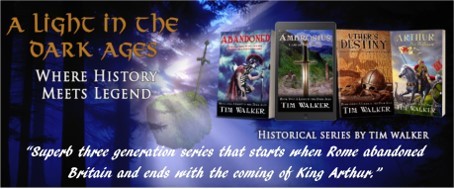
Published on October 02, 2019 19:00
October 1, 2019
Join Historical Fiction author, Mercedes Rochelle, as she takes a look at the life of Thomas Mowbray, Earl of Nottingham #History #Medieval @authorrochelle
Thomas Mowbray, Bolingbroke's adversary
By Mercedes Rochelle
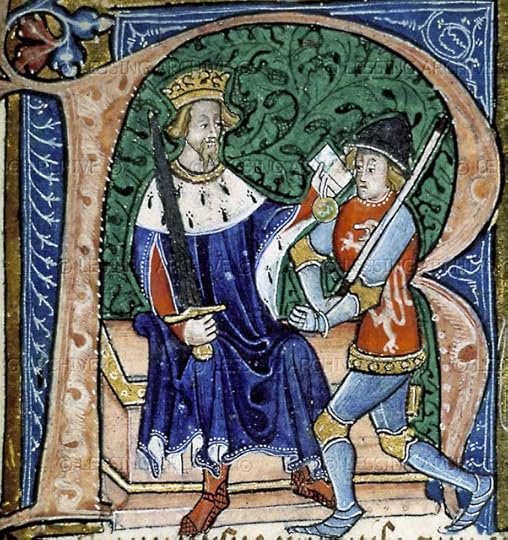 Richard II makes Thomas Mowbray the Earl Marshal, BL Cotton MS Nero D VI, f.85r.
Richard II makes Thomas Mowbray the Earl Marshal, BL Cotton MS Nero D VI, f.85r.Considering that Thomas Mowbray, Earl of Nottingham (and later 1st Duke of Norfolk) participated in almost every major event of Richard II's reign, it's surprising that he's been given so little attention by historians. It is evident that Thomas had a checkered career, in favor then out of favor then back again until his final outlawry. He is often depicted as a slippery character, though it's not clear whether he was motivated by ambition, jealousy, or was he driven by circumstances? It's hard to say, considering how difficult it was to maintain one's equilibrium during Richard II's tempestuous reign.
Orphaned at age two, Thomas and his elder brother John were brought up in the royal court alongside future rival Robert de Vere (another ward). All became close friends with Prince—soon to become King—Richard. John died in 1383, passing on the title Earl of Nottingham to Thomas, who was elected knight of the Garter in the same year. Two years later he was granted the title of Earl Marshal for life. Not bad for a nineteen year-old. He even had an apartment all his own at Eltham, the royal palace—reserved, naturally, for high-ranking nobles.
Nonetheless, trouble was brewing. Robert de Vere had managed to capture Richard's affection and Thomas was increasingly left out. Rather than fight a losing battle he went over to the opposite court faction and married Elizabeth, the daughter of Richard Fitzalan, Earl of Arundel. I would assume he couldn't have found a wife more calculated to alienate the king, though Richard did "distribute liveries of cloth to the earl's wedding guests in 1384" (1). Nonetheless, Mowbray's association with Arundel put him squarely in the Lords Appellant camp, just in time to march against Robert de Vere who was attempting to bring a force from Cheshire to protect the king against his rebellious nobles. Alas, de Vere was no general and his army made a pitiful showing at Radcot Bridge, eventually surrendering with very little loss of life. Robert fled to the Continent; that thorn in Mowbray's side was removed forever.
 Robert de Vere fleeing Radcot Bridge, from Gruthuse Froissart, BN FR 2645, fol.245V
Robert de Vere fleeing Radcot Bridge, from Gruthuse Froissart, BN FR 2645, fol.245V
By then, Henry of Bolingbroke (future King Henry IV) had joined forces with the Lords Appellant, making their number five. After Radcot Bridge the victors confronted King Richard in the Tower, forcing their agenda down his throat and threatening to depose him. Cowed after three days' isolation in the Tower, the king agreed to call parliament. It met in January of 1388, ushering in the worst year of Richard's life.
Bolingbroke and Mowbray, the junior Appellants, mainly kept quiet during the Merciless Parliament, only asserting themselves against their elders when it came time to condemn Richard's beloved vice-chamberlain, Sir Simon Burley. By now, the Merciless Parliament had become a bloodbath and the senior Appellants knew that unless their purge was total, the survivors would demand retribution. Too bad for them that the king himself would take on the mantle of avenger ten years later.
But Richard had noted Mowbray's reticence and decided to bring him back into the fold. In 1389 he made Mowbray Warden of the East March toward Scotland; later Thomas became Captain of Calais and royal lieutenant in the north-east of France. He accompanied the king to Ireland in 1394 and was credited with many successful assignments; he even came within a hair's breadth of capturing Art MacMurchadha abed with his wife. Shortly thereafter, Mowbray went to France to negotiate a truce and Richard's marriage to Princess Isabella.
But Mowbray's uneasy favor with Richard was sorely tested in 1397 when the king launched his tardy retribution against the senior Lords Appellant. Conniving with his new affinity of noble supporters (including Mowbray), Richard initiated a new Appeal against Gloucester, Warwick, and Arundel. Capturing Warwick was easy; the king invited all three to a formal dinner and Warwick was the only one who showed up. A polite, entertaining evening ensued, at the end of which the king ordered the unwary Warwick's arrest. Immediately afterwards, Arundel was persuaded to give himself up. Richard dealt with Gloucester in person. Collecting a large retinue including Mowbray, the king rode all night to Gloucester's Pleshy residence, dragging the sick duke out of bed and arresting him as well. Gloucester was placed into Mowbray's charge and taken to Calais where he was imprisoned in the castle.
The king was adamant; he did not dare appeal Gloucester in person in front of parliament. Politically, that was too volatile. But he needed proof of the duke's guilt relating to the Merciless Parliament of 1388. A lot of suspicious activities took place in Gloucester's prison under the unwilling direction of Thomas Mowbray, Captain of Calais. Eventually a confession was extracted from the duke, and shortly thereafter a sullen Mowbray announced before parliament that Gloucester was dead. No further explanation was forthcoming and after the confession was read Gloucester was condemned as a traitor in absentia. But naturally rumors abounded and Mowbray was implicated beyond a doubt.
After the Revenge Parliament, as it came to be called, the king created a slew of dukes to reward his supporters—sneeringly called "the duketti" by contemporaries. Even Mowbray was created Duke of Norfolk. But it wasn't enough to reassure Thomas. After all, he was one of the five Appellants; now that the king was finished with the instigators he was bound to cast his vengeful eye on the remaining two. From then on, Thomas feared for his own life and stayed away from court as much as he could.

The Challenge of Mowbray and Bolingbroke from Froissart Chronicles, BnF ms. Francais 2646, fol.295
But he finally broke under the stress. In December that same year, Mowbray caught up with Bolingbroke on the road to London. He wasted no time in getting to the point. "Henry, we are about to be undone!" he is said to have declared. When Henry asked him why, he replied, "for what was done at Radcot Bridge".(2) Pretending astonishment (or was he pretending?) Bolingbroke objected: look at the honors Richard showered them with; they had all received pardons. But Mowbray believed none of it. He even told Henry there were men plotting the destruction of him and his father. He hoped Henry would help devise a plan for their mutual defense.But poor Mowbray had badly miscalculated. Far from allying himself with his former Appellant, Bolingbroke made a report to the king (or he told his father who went to the king). Then followed a series of accusations and denials, counter-accusations and further denials. Unable to settle this argument amicably, the court of chivalry decided on a trial by combat. It was to be the event of the decade. Held at Coventry, the tournament was attended by knights from as far away as France, and the two challengers went to great lengths to acquire the very best and most expensive armor and trappings. But all was for naught. As depicted by Shakespeare, as soon as Mowbray and Bolingbroke started their charge, King Richard threw in his baton and halted the fight. After discussing the matter with his council, the king declared that Bolingbroke would be exiled for ten years and Mowbray for life.It was a devastating decision for the Duke of Norfolk. He took his leave shortly thereafter with a small retinue, forbidden to make any contact with Bolingbroke—not that he was very likely to. One wonders if he would have been recalled to England after Henry became king, but we'll never know. He died in Venice just a year later, somewhere around the 22nd or 27th of September in 1399—just a few days before Richard was forced to abdicate. His young son, another Thomas, was not permitted to assume his father's titles and soon involved himself in political turmoil, finally joining the ill-fated revolt of Archbishop Scrope in 1405, where he was beheaded alongside the prelate.1. "The Politics of Magnate Power" by Alastair Dunn, Clarendon Press, Oxford, 2003, p. 402. "Chronicles of the Revolution 1397-1400" by Chris Given-Wilson, p.86
A King Under Siege: Book One of The Plantagenet Legacy
By Mercedes Rochelle

Richard II found himself under siege not once, but twice in his minority. Crowned king at age ten, he was only fourteen when the Peasants' Revolt terrorized London. But he proved himself every bit the Plantagenet successor, facing Wat Tyler and the rebels when all seemed lost. Alas, his triumph was short-lived, and for the next ten years he struggled to assert himself against his uncles and increasingly hostile nobles. Just like in the days of his great-grandfather Edward II, vengeful magnates strove to separate him from his friends and advisors, and even threatened to depose him if he refused to do their bidding. The Lords Appellant, as they came to be known, purged the royal household with the help of the Merciless Parliament. They murdered his closest allies, leaving the King alone and defenseless. He would never forget his humiliation at the hands of his subjects. Richard's inability to protect his adherents would haunt him for the rest of his life, and he vowed that next time, retribution would be his.
Excerpt
Wiping the sweat from his forehead, King Richard leaned against the wall in the practice yard while his friends Thomas and Robert exchanged sword blows, weighed down in full armor despite the summer heat."Keep your arms in front you, Robert. Don't pull back." Michael de la Pole, Richard's resident advisor and arms instructor, moved to the side so he could see better. "Don't let him come too close," he urged.Richard could see that Robert was getting tired. He was having trouble holding up the point of his sword, and Thomas was sure to take advantage of any opening. As soon as Richard thought it, Thomas burst upon his sparring partner with a spurt of energy, knocking his sword aside and assailing him with a succession of blows to the head. Overcome, Robert fell onto his backside and the bout was over. Thomas drew off his helmet and shook his head, sending a shower of sweat over his prone rival.And rivals they were, in more ways than one. Richard pursed his lips, watching as their instructor strode forward and offered a hand to help Robert off the ground. Thomas dismissed Robert with a jerk of his head and walked over to the King. The three youths had spent much of their time together in Edward III's day while Thomas Mowbray and Robert de Vere were wards of the court. Now that Richard was king, they continued their training under the firm hand of Michael de la Pole, an old companion-in-arms of Richard's father the Black Prince. Windsor castle offered the best equipped and most expansive yard for jousting exercises as well as foot training. Though Richard wasn't excited about all this physical activity, he recognized the necessity of it. A king was expected to wage war and that was that. There was no doubt that Thomas showed more aptitude for knightly skills than the other two. That was all right with Richard, though he was slightly annoyed when Thomas went to great lengths to humiliate Robert. De Vere, on the other hand, secure in his friendship with the King, shrugged off any insult as beneath his dignity. That served to aggravate Thomas even more. It was a constant cycle of competition that Richard found tiresome, though at the same time he was flattered. Being king did not remove the need for reassurance.Richard took a sip from a water bottle and handed it to Thomas. "That was a good move. He couldn't stop you."Thomas poured the water on his head before drinking. "It was too easy," he said. "Robert needs to pay more attention.""I will from now on," the other interjected from behind. Thomas scowled at Robert, apparently unruffled despite his embarrassing spill. Robert was a full head shorter than him but better looking, with a thick, curly shock of brown hair and high cheekbones, whereas Mowbray was cursed with a hook nose and crooked teeth. But he was the stronger of the two, which he thought was more important. Good looks were useless in a fight. Coughing to hide his amusement, Richard grinned at his friend. Robert de Vere, earl of Oxford, came from one of the oldest but poorest aristocratic families in England. He was five years older than Richard and married to the King's cousin Philippa. Richard had taken a liking to him right away and it wasn't long before others tried to undermine their relationship, calling Robert greedy and grasping and not terribly stouthearted. But people were always jealous. They could complain all they wanted; Richard wouldn't listen.Michael de la Pole approached, pulling on a set of gloves. "Are you ready, sire? It's your turn, though for now I'm going to attack and you can defend." Richard nodded reluctantly; he wasn't particularly anxious to start another workout, but it was too early to stop for the day. Thomas tightened the King's straps and Robert picked up his helm. Michael waited patiently. Richard was a competent if unenthusiastic fighter; nonetheless, he was a clever lad and showed ingenuity. His skill with horses was impressive, and he could already control his mount with knees and thighs while handling a cumbersome lance and shield. He just needed some more practice with his swordplay. Handsome and cultured, Michael came from a long line of successful merchants; his father had lent King Edward money to pay for his many French campaigns. But he was trying to rise above all that; Michael's recent appointment to Richard's council attested to his skill at diplomacy and political maneuvering. He was pleased that the young King showed more interest in the business of government than the swagger of combat. He had much to teach his young charge. "Sire!" The single word echoed off the stone walls with such urgency that everyone turned. The King frowned as his other advisor approached. He could never overcome a dislike for Richard, Earl of Arundel, assigned to his council since the day he was crowned. The man always trying to control him and tell him what to do. Short and stocky, Arundel had a low forehead and pale blue eyes that bulged from their sockets, reminding Richard of a dead fish. "No time for weapons training now," Arundel said, handing a message to Michael. "I've called a council meeting. We've had a serious disturbance in Essex that demands our immediate attention."Michael glanced up from the paper. "They've assaulted a tax collector," he said. "They are up in arms.""Worse than that," Arundel growled. "They are marching on London."
The Coffee Pot Book Club
★★★★★
Highly Recommended
Read the full review HERE!

Pick up your copy of
A King Under Siege
Amazon UK • Amazon US
Mercedes Rochelle
 Born in St. Louis MO with a degree from University of Missouri, Mercedes Rochelle learned about living history as a re-enactor and has been enamored with historical fiction ever since. A move to New York to do research and two careers ensued, but writing fiction remains her primary vocation. She lives in Sergeantsville, NJ with her husband in a log home they had built themselves.
Born in St. Louis MO with a degree from University of Missouri, Mercedes Rochelle learned about living history as a re-enactor and has been enamored with historical fiction ever since. A move to New York to do research and two careers ensued, but writing fiction remains her primary vocation. She lives in Sergeantsville, NJ with her husband in a log home they had built themselves.Connect with Mercedes: Website • Blog • Facebook • Twitter
Published on October 01, 2019 20:00
September 30, 2019
Read an excerpt of #HistoricalFiction author, Zenobia Neil's, fabulous book — The Queen of Warriors #Giveaway @ZenobiaNeil @hfvbt
Historical Fiction Virtual Blog Tours Presents…
The Queen of Warriors
By Zenobia Neil

Alexandra of Sparta vowed her sword and her heart to the goddess Artemis. And the goddess blessed her. But no warrior lives at peace, and soon, Alexandra loses her title, her troops, and all she holds dear, including the man who holds her heart.Cursed by a Babylonian witch, she is forced to return to a city she once conquered to make amends, but is captured by the powerful Persian rebel, Artaxerxes. As his prisoner, she awaits judgment for her crimes. But Artaxerxes is not what he seems. With death approaching, Alexandra must face her violent past and discover the truth of her captor’s identity before it’s too late.
Praise for The Queen of Warriors
"The Queen of Warriors is a full-blooded adventure into the ancient and mythological world of the warrior queen, Alexandra of Sparta. Imaginative, exciting, and alluring!”Margaret George, author of Helen of Troy
“A sizzling epic that will tempt you into the Hellenistic age. Neil’s writing is smooth, and anyone would be hard-pressed not to fall in love with her kick-ass heroine, Alexandra of Sparta!”Adam Alexander Haviaras, Eagles and Dragons Publishing.
Excerpt

“The goddess cannot break the curse,” the priestess said. “But if you wish, I will ask Hecate to open the gate. Then you may speak to the one who cursed you. Then you can beg for forgiveness.”
Alexandra was not one to beg. She did not fear living men. But Hecate, the triple-headed goddess, the keeper of the crossroads, the goddess of witches—Hecate—the name was like an ice-cold blade on her naked flesh. Yet Alexandra had traversed all the way from deep within the heart of Asia Minor to come here to Ephesus. She had expected the great temple of Artemis to be her destination, but she had been summoned to this cave shrine of Hecate.
She would see it through. “I seek only one of the dead. Will others cross the gate?”
The priestess grinned, exposing her broken teeth. “That depends on your crimes, warrior woman. If those you killed lay unburied and haunt the land of the living, longing for vengeance, they may come through as well.”
“Can they harm me?”
“They are merely shades. It is for you to account for the lives you’ve taken.”
Alexandra lifted her chin. “I regret not a single one of the men I killed, only the deaths I failed to prevent. For those I repent, and for those I am willing to pay, with my life if need be.”
“It will not be that easy.” The priestess withdrew a dagger from a sheath on her waist. The sacrificial blade was short and dark, bronze instead of steel, and had been forged long ago. “Your people know the goddess yearns for mortal blood, as do the shades of the dead. Take this and give them what you will.” She handed Alexandra the dagger, hilt first. “Though I can see you are shrouded in sorrow, it is not your time to die yet. Don’t cut too deep.”
Alexandra approached the black goddess stone on her knees. She raised her left arm, whispered a name, and cut her wrist so the blood began to flow.
The priestess drew a circle around Alexandra and the stone. She pulled a pouch from her robes, uttered an incantation, and sprinkled an herb over the lamps. Soon the scent of myrrh and honey mixed with the iron smell of Alexandra’s blood filled the cavern.
Once the gate to the Underworld opened, the priestess left. Shades of fallen warriors filled the sanctuary, shouting oaths no louder than the wind. Alexandra stared at them, trying to find a familiar face. Though she had lost enough blood to swoon, she swayed on her knees, her back straight, and spoke loudly to the shades.
“If I killed you in battle, you died honorably. If it shames you to have been killed by a woman, know I am not any woman. I am of Sparta—any of my countrymen would have dispatched you just as quickly. Go from this place now, drink from the River Lethe, and find peace.”
The shades did not leave, but they quieted. Her skin prickled with gooseflesh. It was not only fear. Despite the smoke and flames, the temple had grown cold.
One shadow who had been silent all along now grew strong on her blood. Though still transparent and dark, it gained form.
Suddenly able to see the shade, tears came to her eyes.
“Beloved,” she said, her voice breaking, “forgive me. I did not mean it to happen. Tell me what to do. I will give you my life if you wish it.”
The shade gazed at her with a mixture of love, bitterness, and vengeance.
Vishanti, the shade said, the sound no more than a whisper. I cursed you in love, and only by love or justice can you break the curse. You must right the wrongs you have done and face your deepest fear. Return to Rhagae and pay for your crimes.
Alexandra swayed on her knees and brought her hands to her face, allowing herself to sob only once. She had planned to return to Sparta. After all this time, she had been about to journey across the sea, to finally go home. But it seemed the gods had other plans for her.
Giveaway
During the Blog Tour, we are giving away 2 eBooks and 2 paperbacks of Psyche Unbound and The Jinni’s Last Wish! Enter HERE!Giveaway Rules
• Giveaway ends at 11:59 pm EST on October 4th. You must be 18 or older to enter.
• Giveaway is open to the US only.
• Only one entry per household.
•All giveaway entrants agree to be honest and not cheat the systems; any suspicion of fraud will be decided upon by blog/site owner and the sponsor, and entrants may be disqualified at our discretion.• The winner has 48 hours to claim prize or a new winner is chosen.
Pick up your copy ofThe Queen of WarriorsAMAZON
Zenobia Neil
 Zenobia Neil was named after an ancient warrior queen who fought against the Romans. She writes about the mythic past and Greek and Roman gods having too much fun. She lives with her husband, two children, and dog in Los Angeles. The Queen of Warriors is her third book.
Zenobia Neil was named after an ancient warrior queen who fought against the Romans. She writes about the mythic past and Greek and Roman gods having too much fun. She lives with her husband, two children, and dog in Los Angeles. The Queen of Warriors is her third book.Visit her at ZenobiaNeil.com. You can also follow her on Facebook, Twitter, and Goodreads.

Published on September 30, 2019 20:00
Check out Tony Riches fabulous new book — Katherine - Tudor Duchess #HistoricalFiction #Tudors #NewRelease @tonyriches
Katherine’s remarkable true story continues the epic tale of the rise of the Tudors, which began with the best-selling Tudor trilogy and concludes with the reign of Queen Elizabeth I.
Available in eBook and paperback from Amazon UK and Amazon US
(Audiobook edition coming in 2020)
Tony Riches
 Tony Riches is a full-time UK author of best-selling historical fiction. He lives in Pembrokeshire, West Wales and is a specialist in the history of the Wars of the Roses and the lives of the early Tudors. Tony’s other published historical fiction novels include: Owen – Book One Of The Tudor Trilogy, Jasper – Book Two Of The Tudor Trilogy, Henry – Book Three Of The Tudor Trilogy, Mary – Tudor Princess, Brandon – Tudor Knight and The Secret Diary Of Eleanor Cobham. For more information about Tony’s books please visit his website tonyriches.com and his blog, The Writing Desk and find him on Facebook and Twitter @tonyriches
Tony Riches is a full-time UK author of best-selling historical fiction. He lives in Pembrokeshire, West Wales and is a specialist in the history of the Wars of the Roses and the lives of the early Tudors. Tony’s other published historical fiction novels include: Owen – Book One Of The Tudor Trilogy, Jasper – Book Two Of The Tudor Trilogy, Henry – Book Three Of The Tudor Trilogy, Mary – Tudor Princess, Brandon – Tudor Knight and The Secret Diary Of Eleanor Cobham. For more information about Tony’s books please visit his website tonyriches.com and his blog, The Writing Desk and find him on Facebook and Twitter @tonyriches 
Published on September 30, 2019 19:30
September 29, 2019
Join #HistoricalRomance author, Anna Campbell as she explores the trouble with writing a series. Anna is also giving away one Kindle copy of her fabulous book — The Laird’s Willful Lass @AnnaCampbelloz
Series Fever!By Anna Campbell

If any of you have even a passing acquaintance with romance novels, you’ll know that the series is king. Aussie romance writer Stephanie Laurens really launched the craze with her books featuring the tempestuous Cynster family, starting with Devil’s Bride in 1998. This series is still going strong with 20 bestselling novels so far.
I have a good friend currently doing a PhD on series in genre fiction and he finds romance such an anomaly when it comes to how each story links with the others. In romance fiction, most series are made up of several self-contained love stories, usually at least three, sometimes many more, with a guaranteed happy ending for that story’s principal couple at the end of each book.
How is this a series, you ask. Well, the stories usually take place in a unified world and the characters are linked in some way. Often they’re family members. Sometimes they’re linked as friends or colleagues. In my Sons of Sin series, for example, three of the four heroes are friends from Eton where scandal relating to their births made them targets for bullying.
Romance readers want a satisfying end to their love stories, so each book focuses on a particular couple and their journey to happiness. There may be an overarching issue that links all stories – something like finding a missing heiress, or whether the demons massing against our protagonists conquer the world, or who murdered Mr. X – but each story contains a complete plot arc with a happy ending.
One of the joys of series is that characters who star in other stories wander in and out. Readers love an update on how beloved characters get on after “their” book finishes. When you get involved in a series, reading each book is a bit like going to a party full of great friends you haven’t seen for a while. The party might celebrate Fred and Nora’s engagement, but you also get a chance to catch up with Murgatroyd and Wilhelmina. “How are the kids?” “Where are you living now?” “Did you end up getting that promotion?”
I sold my first book to HarperCollins back in 2006 and even then, very few standalone romance novels were being published. Having said that, my first six books were standalones (although there’s a loose link between Claiming the Courtesan, Tempt the Devil, and My Reckless Surrender). When I moved to Hachette for the Sons of Sin books, my editor was determined that I was going to write a series, although Seven Nights in a Rogue’s Bed had been submitted to her as another standalone story.
Sons of Sin ended up being accepted as a trilogy, except…
And this is what I want to talk about today. The trouble with series!
Sons of Sin ended up being six books: four full-length historical romances and two novellas. Not the original plan at all! When you spend so long immersed in a series, you keep coming up with great ideas that fit the landscape. You also meet characters who are screaming out to have their own stories – and readers are screaming for the stories too.
So what is a girl to do but keep writing more books in the series? When I decided to become an independent author, I knew enough to know that writing series was the way to make a career. So I started out with a trilogy about three Regency widows who decide to put aside the sadness of their past and take society by storm.
Do you note I said trilogy? The Dashing Widows ended up being seven books, with the possibility of future spin-offs featuring the next generation. When I got to the end of the sixth book, I said, “That is quite enough.” Except there was this one character who hadn’t had a happy ending and he really deserved one, not to mention he was hero material. Voilà Lord Garson’s Bride which came out early last year.
Currently I’m working on a series about three roguish Highlanders called The Lairds Most Likely. Again, note I said three! Book 1, The Laird’s Willful Lass, came out as planned and introduced Fergus Mackinnon and his friends Diarmid Mactavish and Hamish Douglas. So far, so good, until I needed to write a Christmas story last year. Suddenly Book 2 wasn’t The Highlander’s Lost Lady, Diarmid’s story, it was The Highlander’s Christmas Kissfeaturing a couple of cousins. Lost Lady came out in April as Book 3.

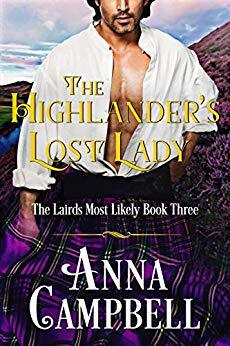

I’m currently finalising Book 4, The Highlander’s Defiant Captive, which I’ll be back to talk about next month. Then there’s this year’s Christmas story, The Highlander’s Christmas Quest. Poor old Hamish will have to wait for his happy ending until 2020 and Book 6, with another book and a Christmas story planned to end the series.
Saying “end the series” provokes a hollow laugh. Because if there’s one thing I’ve learned over the years, it’s that series grow like Topsy! Stay tuned!
The Laird’s Willful LassThe Lairds Most Likely Book 1By Anna Campbell

An untamed man as immovable as a Highland mountain…
Fergus Mackinnon, autocratic Laird of Achnasheen, likes to be in charge. When he was little more than a lad, he became master of his Scottish estate, and he’s learned to rely on his own unfailing judgment. So has everyone else in his corner of the world. He sees no reason for his bride—when he finds her—to be any different.
A headstrong woman from the warm and passionate south…
Marina Luchetti knows all about fighting her way through a wall of masculine arrogance. In her native Florence, she’s become a successful artist, no easy feat for a woman. Now a commission to paint a series of Highland scenes promises to spread her fame far and wide. When a carriage accident strands her at Achnasheen for a few weeks, it’s a mixed blessing. The magnificent landscape offers everything her artistic soul could desire. If only she can resist the impulse to smash her easel across the laird’s obstinate head.
When two fiery souls come together, a conflagration flares.
Marina is Fergus’s worst nightmare—a woman who defies a man’s guidance. Fergus challenges everything Marina believes about a woman’s right to choose her path. No two people could be less suited. But when irresistible passion enters the equation, good sense soon jumps into the loch.
Will the desire between Fergus and Marina blaze hot, then fade to ashes? Or will the imperious laird and his willful lass discover that their differences aren’t insurmountable after all, but the spice that will flavour a lifetime of happiness?
Giveaway
Anna Campbell is giving away one Kindle download copy of her fabulous book
The Laird’s Willful Lass.

All you need to do is answer this question:
Do you have a favourite series, if so, what is it?
Leave your answer in the comments at the bottom of this post.
Giveaway Rules
• Leave your answer in the comments at the bottom of this post.• Giveaway ends at 11:59pm BST on October 8th .You must be 18 or older to enter.• Giveaway is only open Internationally.•Only one entry per household.• All giveaway entrants agree to be honest and not cheat the systems; any suspect of fraud is decided upon by blog/site owner and the sponsor, and entrants may be disqualified at our discretion.•Winners will be announced in the comments.• Winner has 48 hours to claim prize or new winner is chosen.
Pick up your copy ofThe Laird’s Willful LassAmazon UK • Amazon US • Amazon AU • Kobo • iTunes
Anna Campbell
 ANNA CAMPBELL has written 10 award-winning historical romances for Grand Central Publishing and Avon HarperCollins and her work is published in 22 languages. She has also written 23 bestselling independently published romances. Anna has won numerous awards for her Regency-set stories including Romantic Times Reviewers Choice, the Booksellers Best, the Golden Quill (three times), the Heart of Excellence (twice), the Write Touch, the Aspen Gold (twice) and the Australian Romance Readers Association’s favorite historical romance (five times). Anna is currently engaged in writing the Lairds Most Likely series which starts with The Laird’s Willful Lass (2018). When she’s not travelling the world seeking inspiration for her stories, she lives on the beautiful east coast of Australia.
ANNA CAMPBELL has written 10 award-winning historical romances for Grand Central Publishing and Avon HarperCollins and her work is published in 22 languages. She has also written 23 bestselling independently published romances. Anna has won numerous awards for her Regency-set stories including Romantic Times Reviewers Choice, the Booksellers Best, the Golden Quill (three times), the Heart of Excellence (twice), the Write Touch, the Aspen Gold (twice) and the Australian Romance Readers Association’s favorite historical romance (five times). Anna is currently engaged in writing the Lairds Most Likely series which starts with The Laird’s Willful Lass (2018). When she’s not travelling the world seeking inspiration for her stories, she lives on the beautiful east coast of Australia.Connect with Anna: Website • Facebook • Twitter • BookBub • Goodreads.
Published on September 29, 2019 20:00
September 27, 2019
The Coffee Pot Book Club Book Cover of the Month for Septembers is — Sons of the Wolf by Paula Lofting #HistoricalFiction @Paulalofting
The Coffee Pot Book Club
Book Cover of the Month
Goes to...

Sons of the Wolf
By Paula Lofting
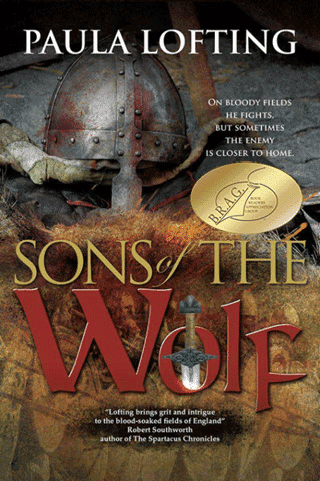
"Bloody. Brutal. Brilliant." - Mary Anne Yarde author of the Du Lac Chronicles founder of the Coffee Pot Book awards.
On the battlefield, Wulfhere fights for his life but elsewhere the enemy is closer to home, sinister and shadowy and far more dangerous than any war.
A forbidden love affair rekindles a dangerous ancient bloodfeud and when Lord Harold, Earl of Wessex, demands that Wulfhere, thegn of Horstede, wed his daughter to his sworn enemy, Wulfhere must find a way to save his daughter from a life of certain misery at the hands of the cruel and resentful Helghi without compromising his honour and loyalty to his lord, Harold.
A tale of Battles & Bloodfeud in the years leading up to the Norman Invasion.
"Paula Lofting has woven an excellent story around the sparse records of historical events that are available from the opening years of the second millennium."
Winner of Chill with a Book Award and BRAG Medallion Award.
It is 1054 and King Edward sits on the throne of England.
Pick up your copy of
Sons of Wolf
Amazon UK • Amazon US
Paula Lofting
 Paula Lofting is the author of two published books in her series set in the Eleventh century:
Sons of the Wolf
, and
The Wolf Banner
. She is currently working on the third book, Wolf’s Bane. A psychiatric nurse by day, she writes in her spare time and also blogs at
1066: The Road to Hastings and Other Stories
.
Paula Lofting is the author of two published books in her series set in the Eleventh century:
Sons of the Wolf
, and
The Wolf Banner
. She is currently working on the third book, Wolf’s Bane. A psychiatric nurse by day, she writes in her spare time and also blogs at
1066: The Road to Hastings and Other Stories
.
Book Cover of the Month
Goes to...

Sons of the Wolf
By Paula Lofting

"Bloody. Brutal. Brilliant." - Mary Anne Yarde author of the Du Lac Chronicles founder of the Coffee Pot Book awards.
On the battlefield, Wulfhere fights for his life but elsewhere the enemy is closer to home, sinister and shadowy and far more dangerous than any war.
A forbidden love affair rekindles a dangerous ancient bloodfeud and when Lord Harold, Earl of Wessex, demands that Wulfhere, thegn of Horstede, wed his daughter to his sworn enemy, Wulfhere must find a way to save his daughter from a life of certain misery at the hands of the cruel and resentful Helghi without compromising his honour and loyalty to his lord, Harold.
A tale of Battles & Bloodfeud in the years leading up to the Norman Invasion.
"Paula Lofting has woven an excellent story around the sparse records of historical events that are available from the opening years of the second millennium."
Winner of Chill with a Book Award and BRAG Medallion Award.
It is 1054 and King Edward sits on the throne of England.
Pick up your copy of
Sons of Wolf
Amazon UK • Amazon US
Paula Lofting
 Paula Lofting is the author of two published books in her series set in the Eleventh century:
Sons of the Wolf
, and
The Wolf Banner
. She is currently working on the third book, Wolf’s Bane. A psychiatric nurse by day, she writes in her spare time and also blogs at
1066: The Road to Hastings and Other Stories
.
Paula Lofting is the author of two published books in her series set in the Eleventh century:
Sons of the Wolf
, and
The Wolf Banner
. She is currently working on the third book, Wolf’s Bane. A psychiatric nurse by day, she writes in her spare time and also blogs at
1066: The Road to Hastings and Other Stories
.
Published on September 27, 2019 23:00
The Coffee Pot Book Club
The Coffee Pot Book Club (formally Myths, Legends, Books, and Coffee Pots) was founded in 2015. Our goal was to create a platform that would help Historical Fiction, Historical Romance and Historical
The Coffee Pot Book Club (formally Myths, Legends, Books, and Coffee Pots) was founded in 2015. Our goal was to create a platform that would help Historical Fiction, Historical Romance and Historical Fantasy authors promote their books and find that sometimes elusive audience. The Coffee Pot Book Club soon became the place for readers to meet new authors (both traditionally published and independently) and discover their fabulous books.
...more
...more
- Mary Anne Yarde's profile
- 159 followers



